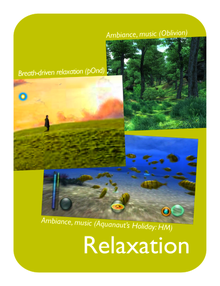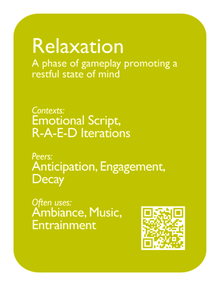Difference between revisions of "Relaxation"
ValterAlves (Talk | contribs) m |
ValterAlves (Talk | contribs) m |
||
| (11 intermediate revisions by the same user not shown) | |||
| Line 29: | Line 29: | ||
Even when a game does not have [[Relaxation]] as its prevalent emotional goal, the phases of [[Relaxation]] are instrumental to build the emotional contrast that will emphasize the value of following phases of [[Anticipation]] or [[Engagement]]. This is particularly relevant, considering that the player's experience is mostly dependent on the interpretation of the game's [[Emotional Script]]. | Even when a game does not have [[Relaxation]] as its prevalent emotional goal, the phases of [[Relaxation]] are instrumental to build the emotional contrast that will emphasize the value of following phases of [[Anticipation]] or [[Engagement]]. This is particularly relevant, considering that the player's experience is mostly dependent on the interpretation of the game's [[Emotional Script]]. | ||
| − | For [[#Additional|historical reasons]], [[Music]] is the most explored means to implement [[Relaxation]]. Yet, other sound | + | For [[#Additional|historical reasons]], [[Music]] is the most explored means to implement [[Relaxation]]. Yet, other sound explorations, namely those that, in turn, resort to [[Entrainment]] techniques, have been effectively used, too. [[Ambiance]] is also commonly explored in association with [[Relaxation]], usually portraying an acoustic environment that is pleasing and not too demanding in terms of attention (which also means not too overloaded with "pleasing" elements). |
| − | The [[Aesthetics|Aesthetic]] qualities of the acoustic composition may also be relevant to [[Relaxation]]. Qualities | + | The [[Aesthetics|Aesthetic]] qualities of the acoustic composition may also be relevant to [[Relaxation]]. Qualities that may be considered positive (e.g., "pleasing") are more prone to induce relaxation that those that may be perceived as negative. Nevertheless, it may also be argued that an excessive (positive) appreciation for the composition, per se, may be counterproductive. To start with, because it can mean an increased level of arousal that would no longer be perceived as [[Relaxation]]; but also because such appreciation may divert the player from the immersion in the game world to an appreciation of the game product itself (which may counter the design intent). |
| additional= | | additional= | ||
| − | Sound has been historically explored as a tool to induce and sustain states of mind, including [[Relaxation]]. At a fundamental level the idea is to create a resonance between the | + | Sound has been historically explored as a tool to induce and sustain states of mind, including [[Relaxation]]. At a fundamental level the idea is to create a resonance between the stimuli and the listener's inner psychophysiological systems through some [[Entrainment]] process, in a state that matches the intended emotional state. In the field of Music this has been done and documented for ages. Cinema also has adopted and adapted the use of [[Music]] to lead the listener to a certain state of mind. In turn, the game industry has considered techniques both from film practice and [[Music]], not forgetting the [[particularities]] of the media, which open new opportunities and call for [[specific approaches]] to [[Music]]. |
| examples= | | examples= | ||
| − | | ex1=<mt p="Relaxation" g="Oblivion" w="{{R16by9W}}" h="{{R16by9H}}"></mt> | + | | ex1=<mt p="Relaxation" g="Oblivion" altg="The Elder Scrolls IV: Oblivion" w="{{R16by9W}}" h="{{R16by9H}}"></mt> |
| − | | ex2=<mt p="Relaxation" g="Pond" w="{{R8by5W}}" h="{{R8by5H}}"></mt> | + | | ex2=<mt p="Relaxation" g="Pond" altg="pOnd" w="{{R8by5W}}" h="{{R8by5H}}"></mt> |
| − | | ex3=<mt p="Relaxation" g="Halo" w="{{R16by9W}}" h="{{R16by9H}}"></mt> | + | | ex3=<mt p="Relaxation" g="Halo" altg="Halo: Reach" w="{{R16by9W}}" h="{{R16by9H}}"></mt> |
| ex4=<mt p="Relaxation" g="Flower" w="{{R16by9W}}" h="{{R16by9H}}"></mt> | | ex4=<mt p="Relaxation" g="Flower" w="{{R16by9W}}" h="{{R16by9H}}"></mt> | ||
| ex5=<mt p="Relaxation" g="Far Cry 2" w="{{R16by9W}}" h="{{R16by9H}}"></mt> | | ex5=<mt p="Relaxation" g="Far Cry 2" w="{{R16by9W}}" h="{{R16by9H}}"></mt> | ||
Latest revision as of 20:54, 24 August 2012

|

| |
| The card's front face | The card's back face |
Synopsis
| A phase of gameplay promoting a restful state of mind. |
Relationships
Contexts:
Emotional Script ![]() , R-A-E-D Iterations
, R-A-E-D Iterations ![]() .
.
Peers:
Anticipation ![]() , Engagement
, Engagement ![]() , Decay
, Decay ![]() .
.
Often uses:
Ambiance ![]() , Music
, Music ![]() , Entrainment
, Entrainment ![]() .
.
Description
Relaxation is one typical phase of the Emotional Script during gameplay. It is used both alone and integrated in an iterated sequence that can also involve some or all of the phases of Anticipation, Engagement, and Decay (the R-A-E-D Iterations).
Even when a game does not have Relaxation as its prevalent emotional goal, the phases of Relaxation are instrumental to build the emotional contrast that will emphasize the value of following phases of Anticipation or Engagement. This is particularly relevant, considering that the player's experience is mostly dependent on the interpretation of the game's Emotional Script.
For historical reasons, Music is the most explored means to implement Relaxation. Yet, other sound explorations, namely those that, in turn, resort to Entrainment techniques, have been effectively used, too. Ambiance is also commonly explored in association with Relaxation, usually portraying an acoustic environment that is pleasing and not too demanding in terms of attention (which also means not too overloaded with "pleasing" elements).
The Aesthetic qualities of the acoustic composition may also be relevant to Relaxation. Qualities that may be considered positive (e.g., "pleasing") are more prone to induce relaxation that those that may be perceived as negative. Nevertheless, it may also be argued that an excessive (positive) appreciation for the composition, per se, may be counterproductive. To start with, because it can mean an increased level of arousal that would no longer be perceived as Relaxation; but also because such appreciation may divert the player from the immersion in the game world to an appreciation of the game product itself (which may counter the design intent).
Examples
Additional Comments
Sound has been historically explored as a tool to induce and sustain states of mind, including Relaxation. At a fundamental level the idea is to create a resonance between the stimuli and the listener's inner psychophysiological systems through some Entrainment process, in a state that matches the intended emotional state. In the field of Music this has been done and documented for ages. Cinema also has adopted and adapted the use of Music to lead the listener to a certain state of mind. In turn, the game industry has considered techniques both from film practice and Music, not forgetting the particularities of the media, which open new opportunities and call for specific approaches to Music.





